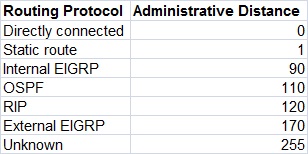Register now or log in to join your professional community.

Administrative distance is a number defines the reliability of a routing protocol,0 to 255 --- 0 high reliable 255 not reachable.
Routing protocol /Route source Default Distance Values Connected interface 0 Static route 1 Enhanced Interior Gateway RoutingProtocol (EIGRP) summary route 5 External Border Gateway Protocol (eBGP) 20 Internal EIGRP 90 IGRP 100 OSPF 110 Intermediate System-to-Intermediate System (IS-IS) 115 Routing Information Protocol (RIP) 120 Exterior Gateway Protocol (EGP) 140 On Demand Routing (ODR) 160 External EIGRP 170 Internal BGP 200 Unknown 255HOP COUNT,routers and gateways as they travel between source and destination.

Hop Count, number of jumps packet has to make to reach the destination router from source router.
Administrative Count, choosing the best path to destination router in the jungle of routers. Lots of different protocols can be used here, such as EIGRP, OSPF, RIP, and Static Route; however, all of them have their own unique administrative counts:
Static Route 1
Internal EIGRP 90
External EIGRP 170
OSPF 110
RIP 120

A network can use more than one routing protocol, and routers on the network can learn about a route from multiple sources to reach a specific destination.
Routers need to find a way to select a better path.
Hop is next reachable router from source router to reach specific destination.
Administrative distance number is used by routers to find out which route is better (lower number is better).



Administrative Distance:
Connected interface 0
Static route 1
EIGRP) summary route 5
External (BGP) 20
Internal EIGRP 90
IGRP 100
OSPF 110
(IS-IS) 115
(RIP) 120
(EGP) 140
(ODR) 160
External EIGRP 170
Internal BGP 200
Unknown* 255

Hop Count is the number of the intermediate devices through which data must pass between soucre and destination, rather than flowing directly over a single wire.
Administrative distance is the feature that routers use in order to select the best path when there are two or more different routes to the same destination from two different routing protocols.
Adminitrative distance for various protocols are:
Default -0
Static -1
RIP -120
Internal EIGRP -90
OSPF -110

Administrative Distance for :
Static route : 1
EIGRP : 5
OSPF : 100

In a most simple analogy , hop counts can be thought of as cities (boundaries). So when we say that Router or network (abc) is (x) hops away, we are thinking of it as how many boundaries or cities do we have to cross in order to get to that city.
In this analogy, I have used cities as separate boundaries, because that's exactly what router does.
Administrative distances are used by routing protocols to select the best possible route between a source and a destination. The link in between could be dealth with different costs (considering many metric factors when it comes to different routing protocols such as link state or distant vectors). But, the main goal is to identify the best available route.
The following list gives a brief info on some of the administrative distances that you mentioned in your question:


Some routing protocols works on the basis of hop count e.g. how many routers are there in path to choose the best path,they'll definately choose the least hop count path they are called distance vector routing protocol,RIPV2 etc.
And some routing protocols works on the basis of bandwidth of the link to choose the best path,so they'll definately choose the high bandwith link to pass the traffic,they are called link state routing protocol for example OSPF,EIGRP.
EIGRP can work on both link state and hop count base.
When a router recieve e.g. RIP and OSPF route to the same network it'll use administrative distance to choose the best path to the network.the administrative distance of some routing protocols is as following:
Connected 0
Static 1
EIGRP
IGRP
OSPF
IS-IS
RIP

The term " hop count" is used only in case of RIP. In simple hope count is the just number of routers. Administrative distance is the value between 0 to 255 used when there are tow or more routes from the different routing protocols to the same destination. For Eg : If you are using rip and ospf both as routing protocols then Ospf will usually will coz it has the better administrative distance (110) compared to rip (120). Administrative distance for default, static route is "1" and For Eigrp internal is "90" and for NBMA network its is "170". Hope this helps. Thank You.

Hop count : - Hop count is usually used by the rip protocol.It denotes the number of routers through which the data is transfers from host to destination OR The number of routers traversed by a packet between its source and destination.
Administrative Distance :- A network can use more than one routing protocol, and routers on the network can learn about a route from multiple sources. Routers need to find a way to select a better path. Administrative distance number is used by routers to find out which route is better (lower number is better). For example, if the same route is learned from RIP and EIGRP, a Cisco router chooses EIGRP route and stores the route in the routing table. This is because EIGRP routes have, by default, an administrative distance of 90, while RIP route have a higher administrative distance of 120.
We can display the administrative distance of all routes on your router by typing the show ip route command.
We can display the administrative distance of all routes on your router by typing the show ip route command.
The following table lists the administrative distance default values:
ROUTING PROTOCOL
ADMINISTRITIVE DISTANCE
Directly Connected
0
Static Route
1
Internal EIGRP
90
OSPF
110
RIP
120
External EIGRP
170
Unknown
255


